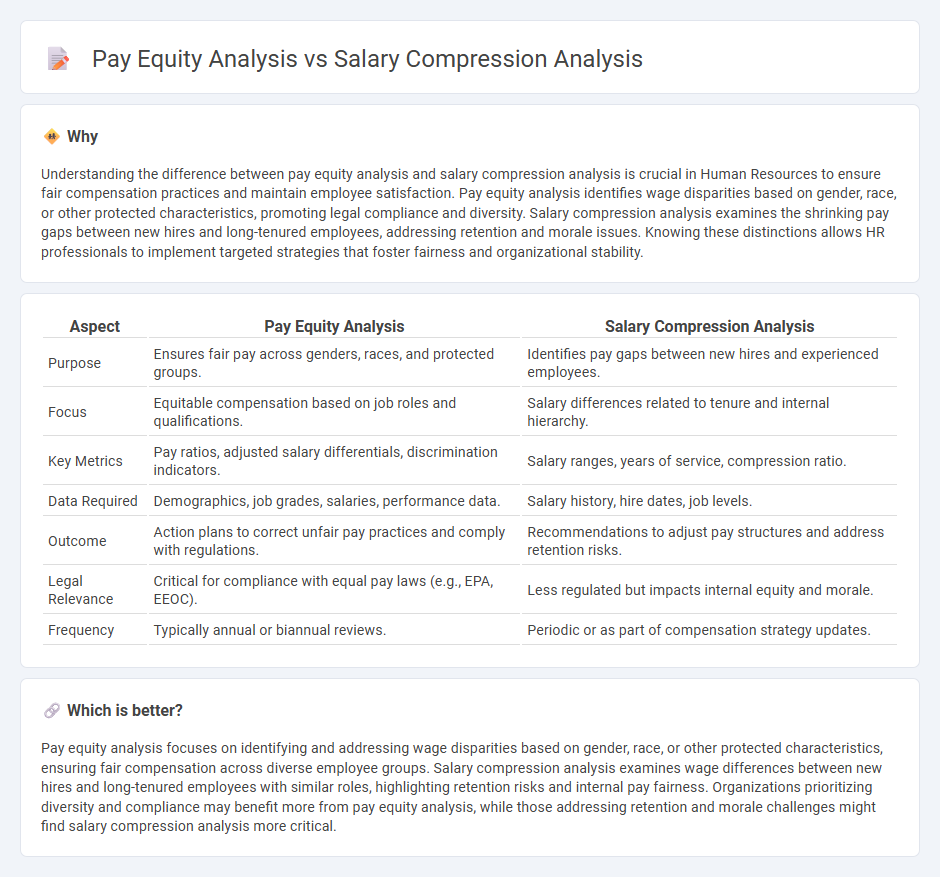
Pay equity analysis focuses on ensuring fair compensation across employees by examining wage disparities related to gender, race, or other protected characteristics. Salary compression analysis evaluates the narrowing pay gaps between new hires and long-tenured employees, highlighting potential retention challenges. Explore how these analyses drive strategic workforce planning and promote organizational fairness.
Why it is important
Understanding the difference between pay equity analysis and salary compression analysis is crucial in Human Resources to ensure fair compensation practices and maintain employee satisfaction. Pay equity analysis identifies wage disparities based on gender, race, or other protected characteristics, promoting legal compliance and diversity. Salary compression analysis examines the shrinking pay gaps between new hires and long-tenured employees, addressing retention and morale issues. Knowing these distinctions allows HR professionals to implement targeted strategies that foster fairness and organizational stability.
Comparison Table
| Aspect | Pay Equity Analysis | Salary Compression Analysis |
|---|---|---|
| Purpose | Ensures fair pay across genders, races, and protected groups. | Identifies pay gaps between new hires and experienced employees. |
| Focus | Equitable compensation based on job roles and qualifications. | Salary differences related to tenure and internal hierarchy. |
| Key Metrics | Pay ratios, adjusted salary differentials, discrimination indicators. | Salary ranges, years of service, compression ratio. |
| Data Required | Demographics, job grades, salaries, performance data. | Salary history, hire dates, job levels. |
| Outcome | Action plans to correct unfair pay practices and comply with regulations. | Recommendations to adjust pay structures and address retention risks. |
| Legal Relevance | Critical for compliance with equal pay laws (e.g., EPA, EEOC). | Less regulated but impacts internal equity and morale. |
| Frequency | Typically annual or biannual reviews. | Periodic or as part of compensation strategy updates. |
Which is better?
Pay equity analysis focuses on identifying and addressing wage disparities based on gender, race, or other protected characteristics, ensuring fair compensation across diverse employee groups. Salary compression analysis examines wage differences between new hires and long-tenured employees with similar roles, highlighting retention risks and internal pay fairness. Organizations prioritizing diversity and compliance may benefit more from pay equity analysis, while those addressing retention and morale challenges might find salary compression analysis more critical.
Connection
Pay equity analysis and salary compression analysis are interconnected processes that address compensation fairness within organizations. Both analyses identify disparities in employee earnings by comparing salaries across roles, tenure, or demographics, aiming to ensure equitable pay structures. Implementing findings from both analyses helps prevent wage stagnation and promotes competitive, fair compensation strategies that enhance employee satisfaction and retention.
Key Terms
**Salary Compression Analysis:**
Salary compression analysis examines wage disparities where experienced employees receive similar pay to new hires, highlighting potential retention risks and morale issues in compensation structures. This analysis focuses on identifying pay gaps caused by market rate adjustments, inflation, or organizational pay scale limitations affecting long-serving staff. Explore how salary compression analysis can optimize your compensation strategy and ensure fair pay equity in your organization.
Internal Equity
Salary compression analysis examines wage disparities between employees with varying tenure or experience levels within the same organization, highlighting potential internal equity issues where newer employees' salaries approach or exceed those of longer-serving colleagues. Pay equity analysis focuses on eliminating compensation differences based on gender, race, or other protected characteristics, ensuring fair and unbiased pay across similar roles and qualifications. Explore further to understand how these analyses drive fair compensation strategies and promote organizational justice.
Salary Range Penetration
Salary compression analysis examines the salary differences between employees with varying tenure or experience levels to identify where salaries cluster too closely, often hindering retention and motivation. Pay equity analysis focuses on fairness and non-discrimination, ensuring equal pay for equal work regardless of gender, race, or other protected characteristics. Understanding Salary Range Penetration within these analyses provides valuable insight into how salaries align with pay grades, guiding better compensation strategies--explore more on optimizing salary structures.
Source and External Links
Identifying and Fixing Pay Compression in Your Organization - This article provides guidance on calculating and addressing pay compression by comparing current salaries to the midpoint of a salary range.
Wage Compression - This document discusses wage compression, including its definition, causes, and consequences, such as pay inequities and decreased employee morale.
Pay Compression: What It Is & What To Do About It - This blog post explains how to identify pay compression through compa-ratios and pay increase histories, and discusses strategies to address it.
 dowidth.com
dowidth.com